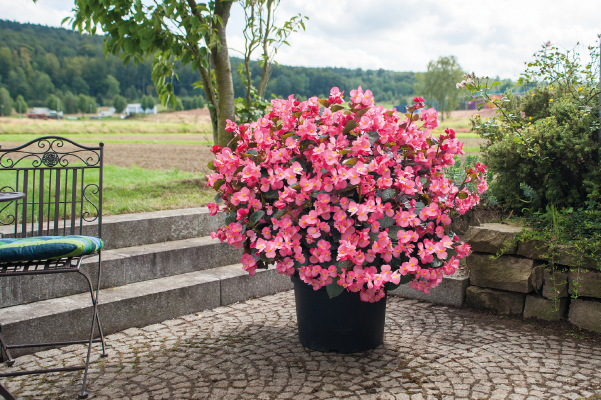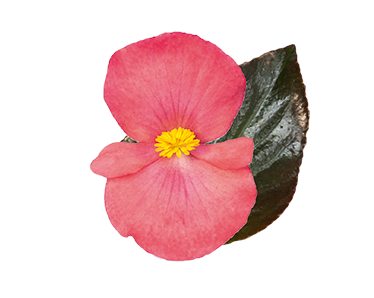

BIG® DeluXXe Rose Bronze Leaf
Item no.: BB0205PA Premium Product for Premium Landscape Application
- 20–25 % larger than BIG®
- Eye-catching season extender with extraordinary flower power
- Outstanding show as well-branched solitary plant
- Rain and drought tolerant, disease resistant
- Thrives in all climates and soils
Technical Guide: Click here
All information in our technical guide is based on our own trials and would therefore be as guideline only. Detailed cultivation aspects vary depending on climate, location, time of year and environmental conditions. Benary expressly disclaims any responsibility for the content of such data/information and makes no representation or warranty for the cultivation of any products listed. It is recommended that growers conduct a trial of products under their own conditions.
- Crop Time
- Spring: 16 - 20 weeks
- Height ∅
- 35 ″ / 90 cm
- Width ∅
- 25 ″ / 63 cm
- Exposure
- Sun - Partial shade
- Seed Form
- Pelleted Seed
- Best Uses
- Bedding, Landscape, Containers, Hanging basket
Culture guide
Usage
Pots, Hanging Baskets, Mixed Containers and Landscape
Sowing method
1-2 seeds or pellets per plug
Germination
Optimum conditions for seedling development, beginning on the day of sowing until radicle emergence. Expect radicle emergence in 6-8 days.
Media
Plug Culture: Begin with a saturated (5) for the first 10 days and on day 11 begin to dry them back slightly to wet (4). This will help in the seedlings rooting into the media. On day 11 begin to alternate between a wet (4) and a moist (3) until day 21. On day 21 it is critical to begin a good wet to dry cycle to prevent algae growth and help with the uptake of nutrients. At this point you can alternate between a wet (4) and a medium (2).
Growing On: Alternate between moisture levels wet (4) and medium (2). Let plants dry back to at least a medium (2) before re-saturating to a wet (4). Extremely dry plants will have a grayish cast to the leaves. Avoid watering plants under high temperature and light when the leaf temperature is excessive. This can cause leaf burn.
Temperature
Plug Culture: 72–76 °F (22–24°C) days 1–11. For irrigation use warm water (above 64°F / 18°C) only.
Growing On: 68–70°F (20–21°C) nights, 64–67°F (18–19°C) days for the first 14 days or until the roots reach the bottom of the container. Thereafter temperatures may be lowered to 62–65°F (16–18°C) day and night. An ADT (average daily temperature of 67°F (19°C) will give the fastest finished crop. Once well established in the final container, approximately two to three weeks after transplanting from a “288” plug tray the temperature can be lowered further to 56-58°F (13-15°C). This will keep the plants toned and prevents too large of leaves.
Fertilization
Plug Culture: Maintain an EC < 1.0. Fertilized water should not exceed an EC of 0.5. Initial feeding should be with a balanced fertilizer low in ammonium. Begin feeding on day 10 with a 14-4-14, 14-2-14 or 17-5-17 fertilizer at 50–60 ppm.
Growing On: Moderate fertilization levels are required. Fertilize the crop weekly with 100-150 ppm nitrogen, using a complete balanced fertilizer. Avoid high ammonium and high nitrogen levels, because the foliage can grow very large. Avoid pH levels above 6.0, as high pH can cause iron deficiency. Watch for low Ca and Mg levels since this can result in stunted plants with marginal leaf edge burn. Under high light conditions use an ammonium based fertilizer (17-5-17) and under low light use a calcium based fertilizer (14-4-14).
Stage I Starts with the radicle breaking through the testa. The roots are touching the medium. Ends with fully developed cotyledons.
Stage II Starts from fully developed cotyledons. Ends with the fully developed true leaf or true leaf pair.
Stage III Starts from the fully developed true leaf or true leaf pair and ends with 80% of the young plants being marketable.
Stage IV All young plants are ready for sale and in the process of being hardened off. This stage lasts about 7 days.
The cultural recommendations are based on results from trials conducted under Central European conditions. Different conditions in other parts of the world may lead to deviations in results achieved.






